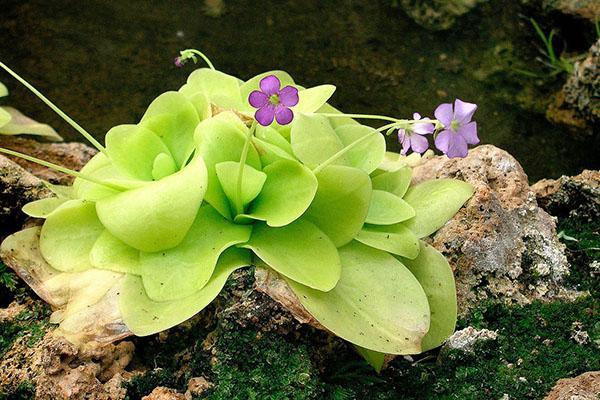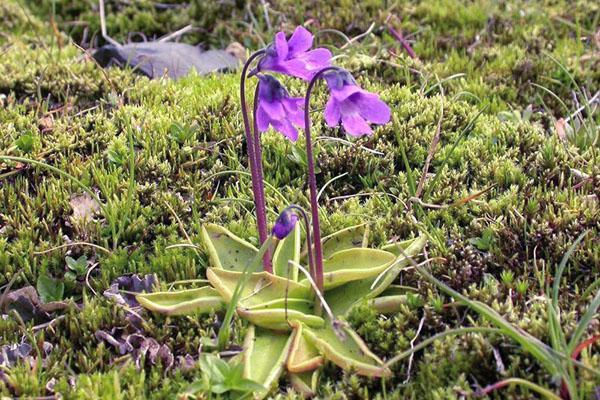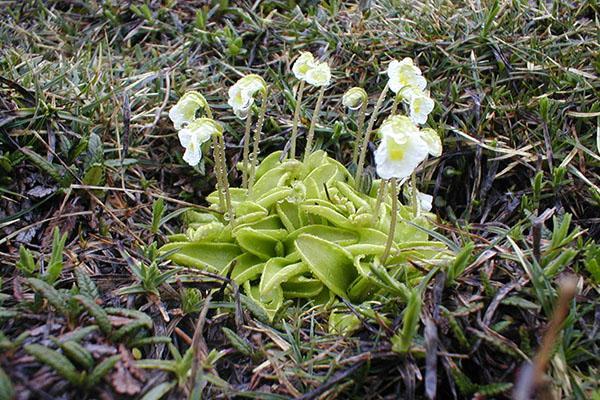Beautiful zhiryanka and its types in your home
 Zhiryanka and its species are carnivorous plants. It is also popularly called oil herb. This is an unusual flower that is increasingly grown indoors. What a carnivorous plant looks like in the photo can be found in this article.
Zhiryanka and its species are carnivorous plants. It is also popularly called oil herb. This is an unusual flower that is increasingly grown indoors. What a carnivorous plant looks like in the photo can be found in this article.
Zhiryanka and its types
A close acquaintance with the types of amazing plants will help create a unique collection in the house.
Common fatweed (pinguicula vulgaris)

Petals can be purple, blue, blue. Very rarely, white and pink buds are found. At the end of flowering, capsules appear in the form of cups. They are abundantly covered with fine hairs on all sides.
As for the leaves, they are ovoid, quite fleshy, light green tone. Their length is about 2-5 cm, and their width is 2 cm. They are sticky to the touch. The stem is straight and long. Its height can reach 17 cm.
In relation to other insect plants, this species is the only one that has a well-developed root system.
Leaves act as an insect catcher. Some of them give off an odor that attracts midges and mosquitoes.
If a large insect hits the plate, the leaf begins to slowly roll up into a tube.
Alpine Zhiryanka

Characteristics:
- The leaves of this species are collected in a root outlet. Each plate is obovate with slightly curved edges. Their color can be either light green or slightly yellowish. The upper part of the plate is abundantly covered with small villi, sticky. The leaves are elongated. They reach 1.5 cm in width and 30 cm in length.
- Peduncles are smooth, erect. Their maximum height is 12 cm. On each of them, one flower is formed. They can be either white or yellowish. Corollas are elongated, slightly pointed at the end.
Alpine beetle pleases with its flowering from June to the end of July.
Moran bead (pinguicula moranensis)
 In summer, the plant forms a basal rosette that grows up to 10 cm. All plates are also covered with mucous glands. Like all other representatives of Zhiryanka, the Moran feeds on various insects.
In summer, the plant forms a basal rosette that grows up to 10 cm. All plates are also covered with mucous glands. Like all other representatives of Zhiryanka, the Moran feeds on various insects.
The flowers of the plant are small. They are often colored purple or pink. The buds are located on a thin, upright stem that will grow up to 25 cm long. With proper care, this species can bloom twice a year.
The most compact is the Moranian Zhiryanka.
The homeland of the Moranian fatty woman is the land of Mexico. It can also be found in Guatemala.
Zhiryanka Tina
 It is a hybrid that was bred from Pinguicula agnate and Pinguicula zecheri. The leaves are also sticky and collected in a colorful rosette. A bush will grow up to 15 cm tall. Flowers are purple, solitary.
It is a hybrid that was bred from Pinguicula agnate and Pinguicula zecheri. The leaves are also sticky and collected in a colorful rosette. A bush will grow up to 15 cm tall. Flowers are purple, solitary.
The advantage of the variety is that it is easily adaptable to different conditions. Tina's fat flower has been blooming for six months.
Platypus fat (Pinguicula planifolia)

The difference between flat-leaved zhiryanka from other types:
- The color of the leaves. In this zhiryanka, they have a burgundy hue.
- Medium socket.Its diameter does not exceed 12.5 cm.
- A bush will grow up to 12 cm tall.
- The flower consists of 5 petals. They come in many shades, but the most common ones are pink, purple and white.
- The buds are small. When unfolded, their diameter does not exceed 2 cm.
Such zhiryanka blooms from March to April. In order for the buds of the flat-leaved zhiryanka to fully open, it is necessary to put the flowerpot with the plant on the western or southern window. If this is not done, then full flowering will not work.
Only in bright sunlight do the leaves of flat-leaved zhiryanka acquire a burgundy hue.
In nature, this species grows on mountain slopes, swamps, meadows. Therefore, at home, zhiryanka must be watered often and abundantly.
The homeland of the plant is the United States. But quite often the flower can be found in France.
Vallisneria fatty
 Pinguicula vallisneriifolia prefers to grow on rocky mountains and in areas with a high limestone content. It is a perennial herb that loves moist soil and partial shade.
Pinguicula vallisneriifolia prefers to grow on rocky mountains and in areas with a high limestone content. It is a perennial herb that loves moist soil and partial shade.
The flower is distinguished by pale pink or purple buds. Very rarely, the petals become white or light blue. Buds form in early May, and flowering lasts until June.
Pinguicula filifolia
 Pinguicula filifolia is found in many countries around the world. The plant prefers wetter areas. In the wild, the bush grows in swamps and near rivers.
Pinguicula filifolia is found in many countries around the world. The plant prefers wetter areas. In the wild, the bush grows in swamps and near rivers.
For the first time this species was bred back in 1866.
The leaves of this zhiryanka grow up to 6 cm long. Their width ranges from 1 to 1.5 cm. Like other species, filamentous catches insects with sticky plates. On a young plant, they are spreading, but every year they rise up. Thus, the bush avoids excess moisture, which causes rotting of the root system.
The rosette reaches 10 cm in diameter. Each has 4 to 6 leaves. The flowers are small, colorful. They consist of five petals of a bluish or whitish hue. The filamentous ghee blooms from July to August. But, if you create conditions for the plant that will be as close to natural as possible, then buds will appear on the bush during all summer months.
Crystal fat is no less popular. For the first time the variety was found on the lands of Turkey. Since then, the plant has not lost its popularity among amateurs and professionals.
Zhiryanka is a very beautiful flower that can decorate any room. With proper care, the plant will constantly delight you with unique buds and the ability to catch insects.